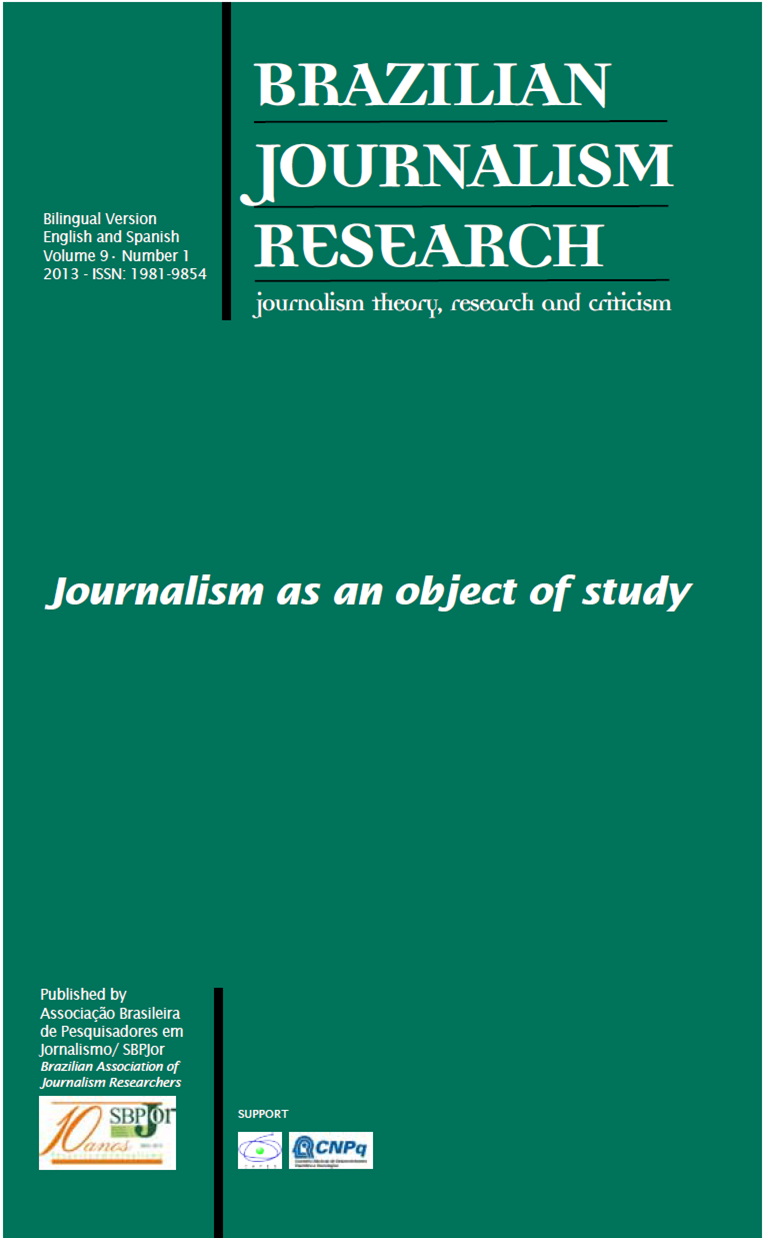Resumo
This paper examines in a historical context, with reference to concrete cases, the phenomenon of spin doctors. What is it? How does it act? What is its purpose? Where does it operate? And what are its consequences? These questions are raised in order to help identify the actions and strategies benefitting news sources, as well as the impact on journalism: the accommodation of journalists, the reduction or elimination of investigative journalism, the transference of the news to digital social networks, and the expansion of media sources. The article draws on a survey conducted with 163 news sources and journalists, on the premise that spin doctors are professional communicators, who are able to forge public opinion using processes, procedures, journalist’s co-optation, and knowledge of journalism and public relations, in order to be successful in the media, or directly with the target audience.
Referências
BERNAYS, Edward. Propaganda. New York: Ig, 2004.
BOORSTIN, Daniel. The image: a guide to pseudo-events in America. New York: Vintage, 1992.
BRASIL. Lei n. 9.610, Fev. 19, 1998. Changes, updates and consolidates the law on copyright. Available at: . Accessed on: Mar. 31, 2013.
BUENO, Wilson da Costa. Comunicação empresarial: políticas e estratégias. São Paulo: Saraiva, 2009.
________. Comunicação empresarial no Brasil: uma leitura crítica. São Paulo: All Print, 2005.
CHAPARRO, Manuel Carlos. Iniciação a uma teoria das fontes: tipificação das fontes. Available at: . Accessed on: Sept. 12, 2009.
________. Linguagem dos conflitos: buscas práticas para uma teoria da ação jornalística. 3. ed. São Paulo: Summus, 2007.
CHARAUDEAU, Patrick. Lés médias el l'information: l'impossible transparence du discours. Bruxelles: De Boeck, 2005.
CHOMSKY, Noam. Media control: the spectacular achievements of propaganda. 2. ed. New York: Seven Stories Press, 2002.
DUARTE, Jorge. Release: história, técnica, usos e abusos. In: _______ (Org.). Assessoria de imprensa e relacionamento com a mídia: teoria e técnica. 3. ed. São Paulo: Atlas, 2010. p. 51-75.
GILLMOR, Dan. We the media: grassroots journalism by the people, for the people. Sebastopol, CA: O'Reilly, 2006.
HABERMAS, Jürgen. História y crítica de la opinión pública: la transformacion estructural de la vida pública. Barcelona: Gustavo Gili, 2003.
HIEBERT, Ray Eldon. Courtier to the crowd: the life story of Ivy Lee, distinguished founder modern public relations. Ames: Iowa State University Press, 1966.
HOLIDAY, Ryan. Trust me, i'm lying: confessions of a media manipulator. New York: Portfolio, 2012.
JONES, Nicolas. Soundbites and spin doctors: how politicians manipulate the media and vice versa. London: Cassel, 1996.
KUCINSKI, Bernardo. A pauta econômica e a agenda das assessorias de imprensa. In: DINES, Alberto (Org.). A mídia e os dilemas da transparência. Brasília: Banco do Brasil, 2002. p. 55-59.
LAGE, Nilson. A reportagem: teoria e técnica de entrevista e pesquisa jornalística. Rio de Janeiro: Record, 2001.
LIMA, Gerson Moreira. Releasemania: uma contribuição para o estudo do press-release no Brasil. 2. ed. São Paulo: Summus, 1985.
LIMA, Samuel. O Facebook e a espetacular construção unilateral da “verdade”. ObjEthos, October 24, 2012. Available at: . Accessed on: Oct. 24, 2012.
LIPPMANN, Walter. Public opinion. New York: Macmillan, 1960.
LUHMANN, Niklas. The reality of the mass media. Palo Alto, CA: Stanford University Press, 2000.
MALTESE, John Antohony. Spin control: the White House office of communications and the management of presidential news. 2. ed. Chapel Hill, NC: The University of North Carolina Press, 1994.
PILGER, John. The new propaganda is liberal: the new slavery is digital. New Statesman, London, 14 mar. 2013. Available at: . Accessed on: Mar. 18, 2013.
PRICE, Lance. The Spin doctor's diary: inside number 10 with New Labour. London: Hodder & Stoughton, 2006.
ROUSSEAU, Jean-Jacques. Du contrat social. Paris: Flammarion, 2012.
SANT'ANNA, Francisco. Mídia das fontes: um novo ator no cenário jornalístico brasileiro. Brasília: Senado Federal, 2009.
SCHMITZ, Aldo Antonio. Fontes de notícias: ações e estratégias das fontes no jornalismo. Florianópolis: Combook, 2011.
SINGER, André et al. (Org.). No Planalto com a imprensa: entrevistas de secretários de imprensa e porta-vozes, de JK a Lula. v. 2. Brasília: Massangana, 2010.
SOUSA, Jorge Pedro. Planificando a comunicação em relações públicas. Florianópolis: Letras Contemporâneas, 2004.
STAROBIN, Paul. All the president's pundits. Columbia Journalism Review, New York, Sept/Oct. 2011.
SUMPTER, Randy; TANKARD JR, James W. The Spin doctor: an alternative model of public relations. Public Relations Review, v. 20, n.1, Sept. 1994. p. 19-27.
THE NEW YORK TIMES. The debate and spin doctors. Oct. 21, 1984. Available at: . Accessed on: Feb. 20, 2013.
TYE, Larry. The father of spin: Edward L. Bernays and the birth of public relations. New York: Crown, 1998.
VANDEHEI, Jim; ALLEN, Mike. Obama, the puppet master. Politico: Behind the curtain. February 18, 2013. Available at: . Accessed on: Mar. 13, 2013.
WEY, Hebe. O processo de relações públicas. 4. ed. São Paulo: Summus, 1986.
Os direitos autorais dos artigos publicados nesta revista são de propriedade dos autores, com direitos de primeira publicação para o periódico. Em virtude da aparecerem nesta revista de acesso público, os artigos são de uso gratuito, com atribuições próprias, para fins educacionais e não-comerciais.
This work is licensed under a Creative Commons Attribution-NonCommercial-NoDerivatives 4.0 International License.


